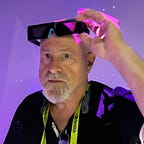CES 2017 Media Day Redux
Panels, Parties & Start Ups — Oh, My!
The show floor was still buzzing with lumbering teamsters on scissor lifts as press, exhibitors and $1700 premium pass holders filed into the North Hall of the cavernous Las Vegas Convention Center for a day of panels with sexy titles. I focused my day on three panels of Industry experts prognosticating on the future of new AR and VR technology, consumers and products.
The first and most popular panel, attended by three hundred people. was “AR/VR and the Future of Content”. The panel was moderated by Technicolor’s Lane Cooper, and featured Nonny de la Peña , CEO , Emblematic Group, a VR consultant who was an early evangelist of Oculus, Meenakshi Ramasubramanian, of the Consumer Technology Association, who has been researching consumer awareness of VR, Jeffrey Powers, co-Founder & CEO, Occipital, which just introduced its Bridge AR headset for iPhone, and Dr. S. “Jay” Jayaram, Chief Strategist for VOKE VR, which was recently acquired by Intel. The panelists themselves were much more impressive than the content of the panel. All agreed it’s early in the development of the technology and each has distinct approaches to creating products in this crude context.
It would have been more compelling if each panelist was able to give a fifteen minute presentation of what they are working on instead of taking softball questions from the moderator and the audience, including (natch) myself. I still don’t understand why 360 video requires a headset or why we call it VR. As I wrote yesterday, 360 video, with support from FB and YouTube, is poised to explode. What I really wanted to hear was the founder and CEO of Occipital talk about their pioneering work in AR, and their brilliant, untethered Bridget headset which uses inside out positional tracking for the iPhone. Bridge uses the open source VR development engine Unity, and shipped its developer version last month. After watching the video above, and listening to Jeff Powers, I would not be surprised if they are acquired by Apple this year. “The cost needs to come down,” he said, “and the content needs to go up” for AR/VR to reach scale. Bridge, or Bridget, as the app is called, is an important first step.
The second panel, “Pokemon GO - The Phenomenon of AR Gets Real” also featured a distinguished panel of experts. The moderator was Ariella Lehrer, Ph.D., CEO and President, Legacy Interactive and Legacy Games and the panelists Jerri Lynn Hogg, a Media Psychologist, veteran games developer Don Daglow, Keyvan Peymani, Partner, Touchdown Ventures, Brian Marr, Chief Strategy Officer, Smashing Ideas and Matthew Short, R&D Manager, Accenture Technology Labs. Oddly, the first thing the panel agreed on was that Pokemon Go was not AR. It was simply a casual mobile game that used geocaching and nostalgia to become a phenomenon and make a billion dollars. Not surprisingly, it was developed by a team at Google.
Google’s work on project Tango can only be seen on Lenovo’s smart phone right now. There are only 35 apps in the Play Store, but according to Lauren Goode of The Verge, despite its prototypical qualities, “people who see this technology have their minds blown.” The system uses the camera on the phone as advanced sensors to map the world and place virtual objects within it, allowing you to own virtual pets, or conjure dinosaurs, or rearrange furniture in a room.
Panelist Dan Daglow, a veteran developer and game “script doctor”, predicted “small teams will make big money” developing for the emerging AR mobile platform.
The final panel I attended, “Virtual Reality Transforms Media — TV, Movies and News, was moderated by Seth Shapiro, the President of the Academy of Interactive Arts and Sciences, and included Jeff Nicholas, Creative Director for Live Nation, Dylan Flinn, Creative Artist Agency, Sami Ramly, of Wevr, and Ted Schilowitz, Futurist , 20th Century Fox. The theme of the panel seemed to be “nobody knows anything” and “we’re working on it”. They praised “The Martian” and “Gnomes and Goblins” VR experiences. The most interesting moment came when Schilowitz, the “Futurist” at Fox (what an epic title) gave an impassioned speech encouraging would be VR producers to acquire 360 rigs and spend a couple of thousand dollars creating new content. “The field is wide open for experimentation,” he said, “and every group within the studio has them dedicated to developing content for new platforms.”
The final event worth talking about was the satellite start up showcase at the Golden Spike downtown. Attended by several thousand people, the din and crushing crowd inside the venue made it hard to learn details about the start ups, but they will also be on the show floor, which I’ll be exploring over the next several days. The general theme seemed to be The Internet of Things, in particular home sensors for health and security, and wearables.
As for the other parties, there was really great food, free booze, and modest schmoozing with other attendees. People are excited by the explosion of car technology, driverless cars, electric cars. This is a huge theme at CES this year. BMW, Volvo, Honda, Ford, Audi, Tesla and many others have huge visibility here and are likely to be covered heavily by the press.
Like this story? Get more in the weekly newsletter from CinematicVR.
